Wet Etching of Quartz Using a Solution Based on Organic Solvents and Anhydrous Hydrofluoric Acid
Abstract
1. Introduction
2. Materials and Methods
2.1. Materials
2.2. Equipment
2.3. Methods
3. Results
3.1. Temperature Factor
3.2. Water Content
3.3. Surface Morphology
3.4. Frequency Characteristics and Electrical Performance
3.5. Temperature–Frequency/Resistance Characteristics
4. Discussion
- Er is the etching rate;
- is defined as the percentage of the number of collisions that will have sufficient energy and occur at the proper orientation to create a reaction;
- is defined as the level of energy required to cause a reaction. The value is dependent on temperature only and is not affected by concentration or any other factors [30]. The value is represented by a well-established relationship first proposed by Arrhenius and forms the basis of an activation-controlled reaction. The result is exponential relative to temperature. The value is defined by the following equation [31]:where
- Ea = activation energy (joules);
- R = universal gas constant;
- T = temperature (Kelvin).
5. Conclusions
- Compared with the BOE solution, the anhydrous etching solution has a lower etching rate (nearly 10 times lower) and less fluctuation in the rate (almost 25 times smaller), which are good for process control in mass production.
- For the anhydrous etching solution, it was found that even 10% of water content had a significant impact on the etch rate and the wafer surface quality.
- The surface morphology and electrical-property parameters of quartz blanks etched in anhydrous etching solution are better than those etched in the BOE solution.
- The quality of the surface morphology of the quartz wafer will directly affect the frequency waveform of the wafer and will have a significant impact on the electrical performance, DLD characteristics, and temperature–frequency characteristics of the resonator which is made by this wafer. The lower the surface roughness of the wafer, the better the above performance parameters will be.
Author Contributions
Funding
Institutional Review Board Statement
Informed Consent Statement
Data Availability Statement
Conflicts of Interest
References
- Ling, R.; Chao, M.; Shen, J.; Shen, L.; Li, Z.; Wang, J. The Effect of Surface Roughness on the Performance of Quartz Crystal Resonators. In Proceedings of the 14th Symposium on Piezoelectrcity, Acoustic Waves and Device Applications (SPAWDA), Shijiazhuang, China, 1–4 November 2019; pp. 1–5. [Google Scholar]
- Matko, V. Next generation AT-cut quartz crystal sensing devices. Sensors 2011, 11, 4474–4482. [Google Scholar] [CrossRef] [PubMed]
- Danel, J.S.; Delapierre, G. Quartz: A material for microdevices. J. Micromech. Microeng. 1991, 1, 187. [Google Scholar] [CrossRef]
- Vig, J.R. Quartz crystal resonators and oscillators for frequency control and timing applications: A tutorial. NASA Sti/Recon Tech. Rep. N 1994, 95, 19519. [Google Scholar]
- Ballato, A. Basic material quartz and related innovations. In Piezoelectricity; Springer: Berlin/Heidelberg, Germany, 2008; pp. 9–35. [Google Scholar]
- Gablech, I.; Brodský, J.; Pekárek, J.; Neužil, P. Infinite Selectivity of Wet SiO2 Etching in Respect to Al. Micromachines 2020, 11, 365. [Google Scholar] [CrossRef] [PubMed]
- Ye, H.; Li, Y.; Jiang, C.; Chen, Q. Wet chemical etching for polishing fused quartz elements. Opt. Precis. Eng. 2020, 28, 382–389. [Google Scholar]
- Tatsumi, T.; Fukuda, S.; Kadomura, S. Etch Rate Acceleration of SiO2 during Wet Treatment after Gate Etching. Jpn. J. Appl. Phys. 1993, 32, 6114. [Google Scholar] [CrossRef]
- Hedlund, C.; Lindberg, U.; Bucht, U.; Soderkvist, J. Anisotropic etching of Z-cut quartz. J. Micromech. Microeng. 1993, 3, 65. [Google Scholar] [CrossRef]
- Liang, J.; Kohsaka, F.; Matsuo, T.; Ueda, T. Wet etched high aspect ratio microstructures on quartz for MEMS applications. IEEJ Trans. Sens. Micromachines 2007, 127, 337–342. [Google Scholar] [CrossRef]
- Clower, W.; Rodrigue, E.; Wilson, C.; Kaajakari, V. Electrical control for wet etching of quartz resonators. In Proceedings of the 2009 IEEE International Frequency Control Symposium Joint with the 22nd European Frequency and Time Forum, Besancon, France, 20–24 April 2009. [Google Scholar]
- Watanabe, T. Mass production of quartz high-speed chemical etching applied to AT-cut wafers. In Proceedings of the 2001 IEEE International Frequncy Control Symposium and PDA Exhibition (Cat. No. 01CH37218), Seattle, WA, USA, 8 June 2001. [Google Scholar]
- Hou, Z.; Wu, X.; Xiao, D.; Chen, Z. Structural improvement in resonant silicon sensors to sub-ppm/°C temperature coefficient of resonance frequency. J. Micro/Nanolithogr. 2014, 13, 013016. [Google Scholar] [CrossRef]
- Liang, J.; Huang, J.; Zhang, T.; Zhang, J.; Li, X.; Ueda, T. An Experimental Study on Fabricating an Inverted Mesa-Type Quartz Crystal Resonator Using a Cheap Wet Etching Process. Sensors 2013, 13, 12140–12148. [Google Scholar] [CrossRef] [PubMed]
- Shariar, K.F.; Zhang, J.; Coasey, K.; Sufian, M.A.; Remy, R.; Qu, J.; Mackay, M.; Zeng, Y. The effects of ICP dry etching and HF wet etching on the morphology of SiO2 surface. Mater. Res. Express 2018, 5, 095903. [Google Scholar] [CrossRef]
- Gao, Y. Study on the etching rate of silicon dioxide in semiconductor process. Microprocessors 2020, 41, 17–19. [Google Scholar]
- Ferrando, N.; Gosálvez, M.A.; Colom, R.J. Evolutionary continuous cellular automaton for the simulation of wet etching of quartz. J. Micromech. Microeng. 2012, 22, 025021. [Google Scholar] [CrossRef]
- Xing, Y.; Gosalvez, M.A.; Zhang, H.; Li, Y.; Qiu, X. Transient and stable profiles during anisotropic wet etching of quartz. J. Microelectromech. Syst. 2017, 26, 1063–1072. [Google Scholar] [CrossRef]
- Kopitkovas, G.; Deckert, V.; Lippert, T.; Raimondi, F.; Schneider, C.W.; Wokaun, A. Chemical and structural changes of quartz surfaces due to structuring by laser-induced backside wet etching. Phys. Chem. Chem. Phys. 2008, 10, 3195–3202. [Google Scholar] [CrossRef]
- Zhang, H.; Xing, Y.; Li, Y.; Gosálvez, M.A.; Qiu, X. Kinetic Monte Carlo method for the simulation of anisotropic wet etching of quartz. Sens. Actuators A Phys. 2017, 256, 24–34. [Google Scholar] [CrossRef]
- Zeze, D.A.; Forrest, R.D.; Carey, J.D.; Cox, D.C.; Robertson, I.D.; Weiss, B.L.; Silva, S.R. Reactive ion etching of quartz and Pyrex for microelectronic applications. J. Appl. Phys. 2002, 92, 3624–3629. [Google Scholar] [CrossRef]
- Rangsten, P.; Hedlund, C.; Katardjiev, I.V.; Bäcklund, Y. Etch rates of crystallographic planes in Z-cut quartz-experiments and simulation. J. Micromech. Microeng. 1998, 8, 1. [Google Scholar] [CrossRef]
- Xing, Y.; Zhang, J.; Gosálvez, M.A.; Zhang, H.; Li, Y.; Zhou, S. The maximum positive curvature recognition method to determine etch profiles in wet etching of quartz on AT and BT cuts. J. Microelectromech. Syst. 2018, 27, 730–738. [Google Scholar] [CrossRef]
- Yamamura, K. Development of numerically controlled local wet etching. Sci. Technol. Adv. Mater. 2007, 8, 158. [Google Scholar] [CrossRef][Green Version]
- Lipatieva, T.O.; Lipatiev, A.S.; Kulakova, Y.V.; Lotarev, S.V.; Fedotov, S.S.; Prusova, I.V.; Sigaev, V.N. Control of Liquid Laser-Induced Etching of Quartz Glass. Glass Ceram. 2022, 78, 345–349. [Google Scholar] [CrossRef]
- Wegner, M.W.; Christie, J.M. Chemical etching of deformation sub-structures in quartz. Phys. Chem. Miner. 1983, 9, 67–78. [Google Scholar] [CrossRef]
- Neumeier, D.A. Chemical milling of quartz using a solution based on organic solvents and anhydrous hydrofluoric acid. In Proceedings of the 2002 IEEE International Frequency Control Symposium and PDA Exhibition (Cat. No. 02CH37234), New Orleans, LA, USA, 31 May 2002; pp. 394–402. [Google Scholar]
- Holum, J.R. Introduction to Organic and Biological Chemistry; Wiley: Hoboken, NJ, USA, 1969. [Google Scholar]
- Vig, J.R.; LeBus, J.W.; Filler, R.L. Chemically Polished Quartz; Army Electronics Command Fort: Monmouth, NY, USA, 1977. [Google Scholar]
- Ward, R.W. Etching of quartz crystal spheres. In Proceedings of the 1993 IEEE International Frequency Control Symposium, Salt Lake City, UT, USA, 2–4 June 1993; pp. 390–396. [Google Scholar]
- Suda, P.; Zumsteg, A.E.; Zingg, W. Anisotropy of etching rate for quartz in ammonium bifluoride. In Proceedings of the 33rd Annual Symposium on Frequency Control, Atlantic City, NJ, USA, 30 May–1 June 1979; pp. 359–363. [Google Scholar]
- Vig, J.R.; Brandmayr, R.J.; Filler, R.L. Etching Studies on Singly and Doubly Rotated Quartz Plates; Electronics Technology & Devices Laboratory Headquarters: Fort Monmouth, NJ, USA, 1980. [Google Scholar]

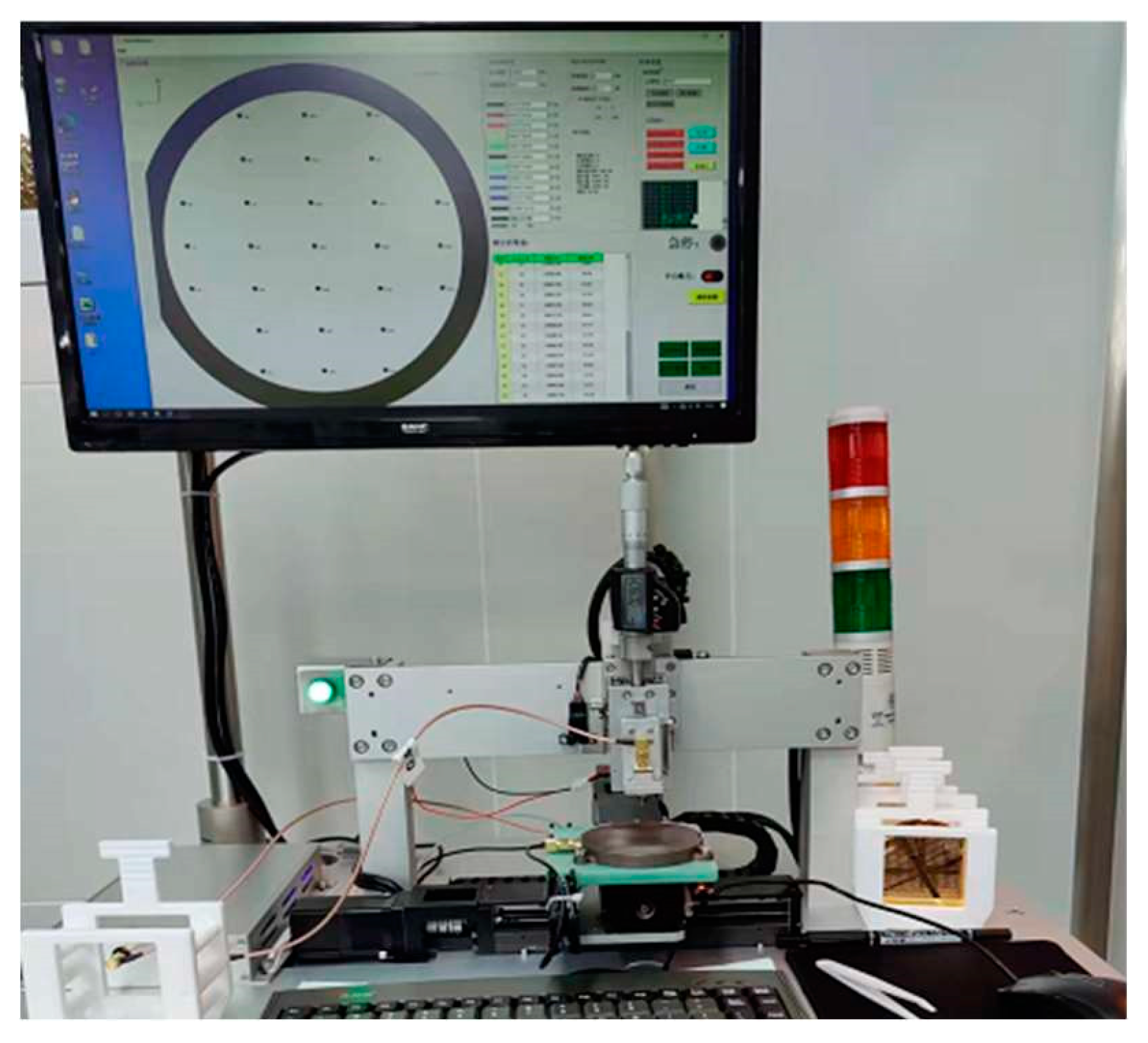
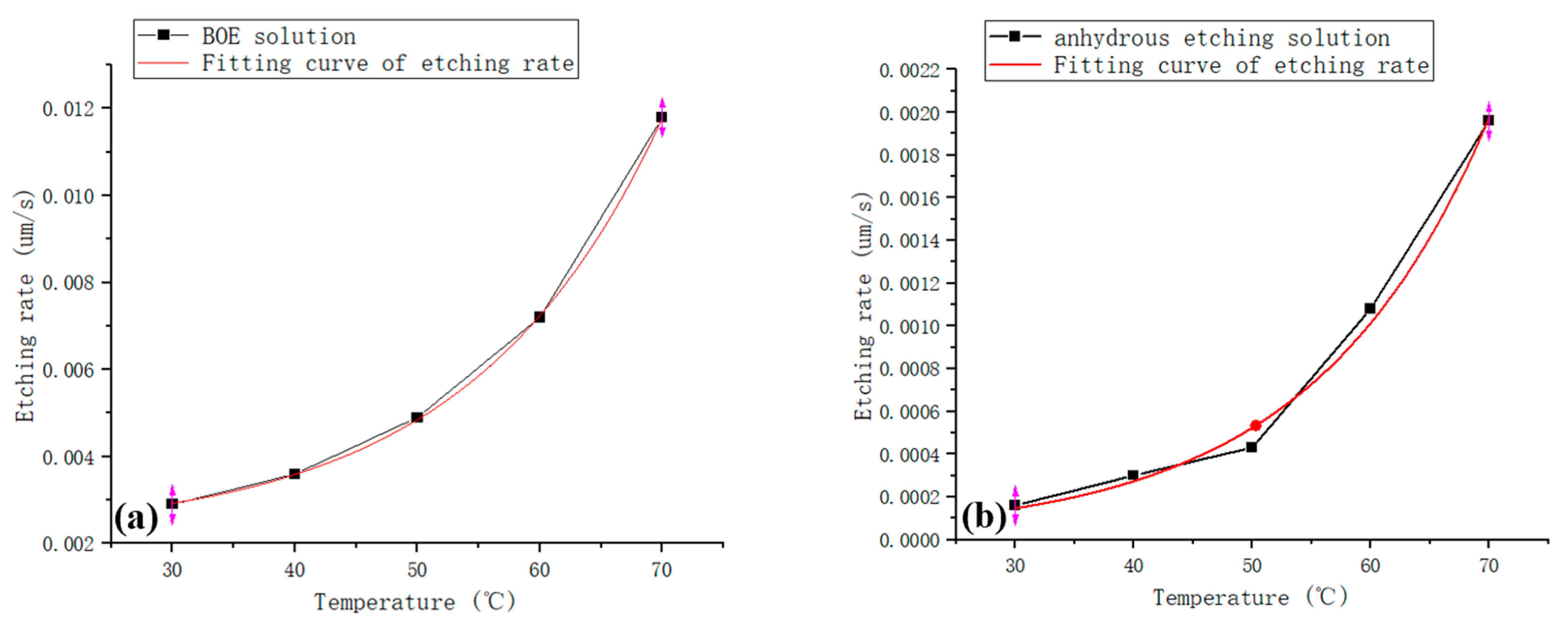

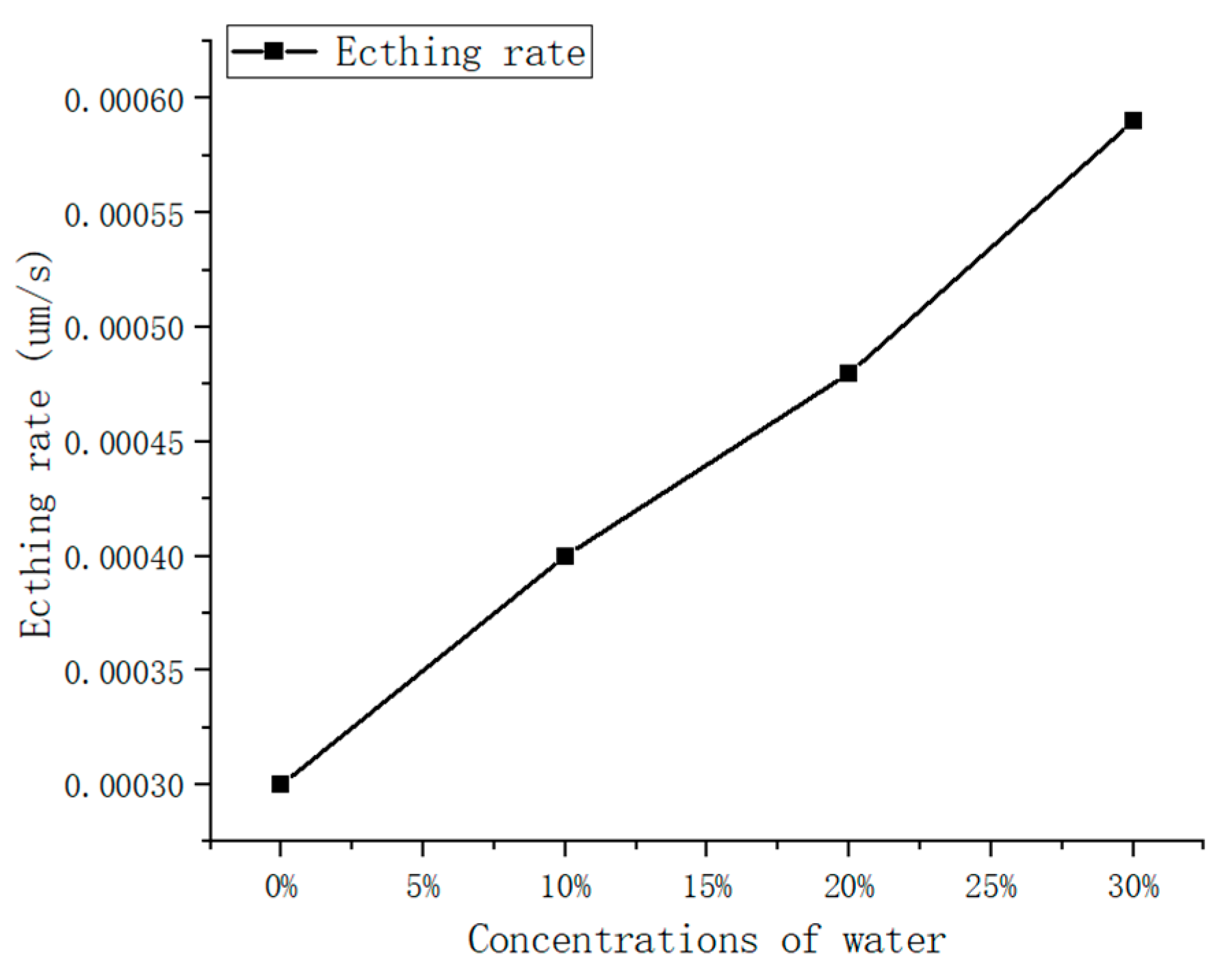


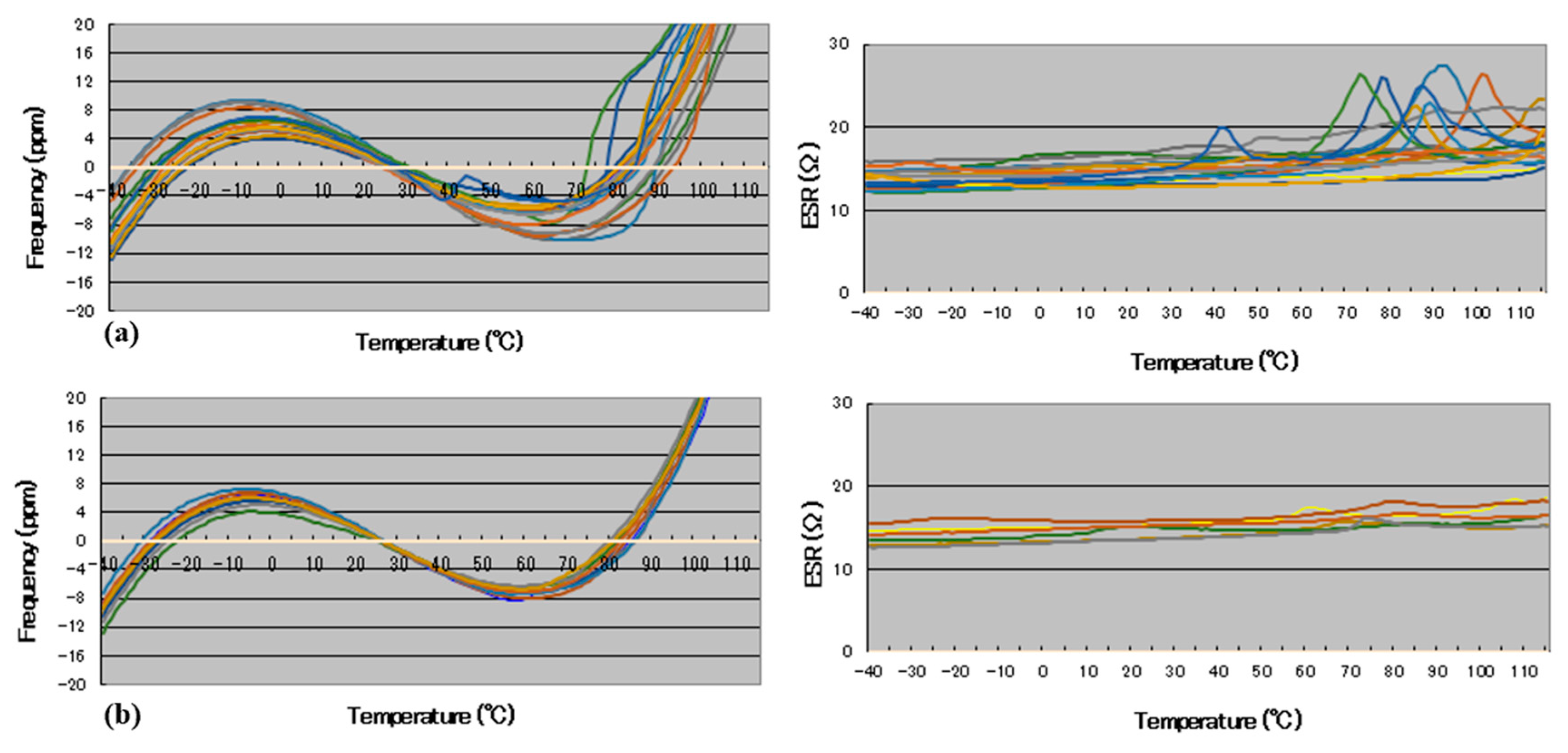

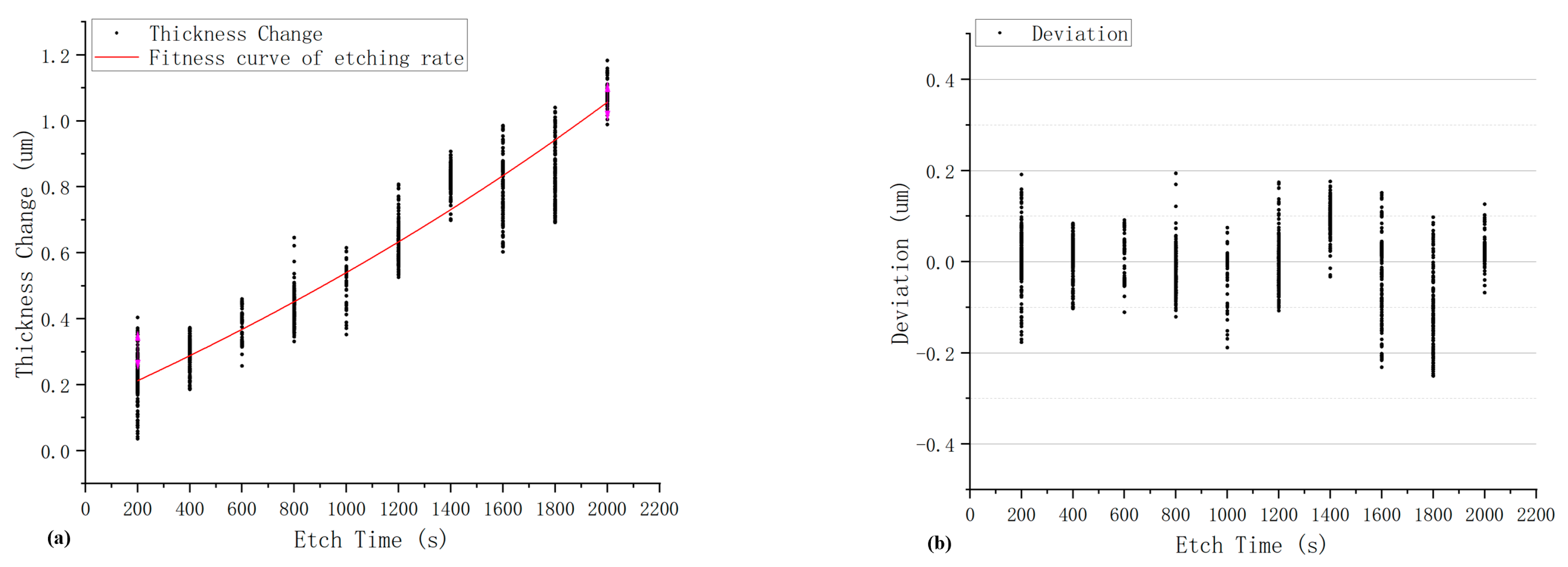
| Solution | Parameter | Nominal | Limits | Measured |
|---|---|---|---|---|
| BOE solution | HF | 25.6% | ±0.5 | 25.49% |
| NH4F | 19.6% | ±0.3 | 19.77% | |
| Particles (≥0.5 um, pcs/mL) | NA | ≤160 | 33 | |
| Hazen | NA | ≤10 | <10 | |
| Chloride (Cl) | NA | ≤3 | <3 | |
| Sulfate (SO4) | NA | ≤1.5 | <1.5 | |
| Phosphate (PO4) | NA | ≤0.5 | <0.5 | |
| Anhydrous etching solution | HF Concentration | 20.0 mol | ±0.3 | 20.181 mol/L |
| Sulfur Dioxide | NA | <15 ppm | 0.327 ppm | |
| Fluorosilicic Acid | NA | <15 ppm | 0.097 ppm | |
| Sulfuric Acid | NA | <25 ppm | 0.64 ppm | |
| Water | NA | <0.03% | 0.0075% | |
| Density (g/mL) at 25 °C | 1.129 | ±0.005 | 1.129 |
| Group | Etching Solution | Etching Temperature (°C) | Volume Ratio of Water and Solution |
|---|---|---|---|
| 1 | BOE solution | 30/40/50/60/70 | - |
| 2 | anhydrous etching solution | 30/40/50/60/70 | - |
| 3 | anhydrous etching solution | 40 | 1:10 |
| 4 | anhydrous etching solution | 40 | 1:5 |
| 5 | anhydrous etching solution | 40 | 3:10 |
| 6 | BOE solution | 40 | - |
| 7 | anhydrous etching solution | 40 | - |
| Group | Status | Ra (nm) | Rz (nm) | Rq (nm) |
|---|---|---|---|---|
| 6 | Before etching | 0.545 | 41.547 | 3.869 |
| 7 | Before etching | 0.541 | 16.658 | 1.114 |
| 6 | After etching | 6.109 | 44.718 | 7.279 |
| 7 | After etching | 0.911 | 18.703 | 1.165 |
| Group | R (Ω) | RLD2 (Ω) | DLD2 (Ω) | FDLD (PPM) | Quantity (pcs) |
|---|---|---|---|---|---|
| 6 | 23.86 | 25.7 | 5.14 | 4.14 | 100 |
| 7 | 16.11 | 16.6 | 0.92 | 1.08 | 100 |
Publisher’s Note: MDPI stays neutral with regard to jurisdictional claims in published maps and institutional affiliations. |
© 2022 by the authors. Licensee MDPI, Basel, Switzerland. This article is an open access article distributed under the terms and conditions of the Creative Commons Attribution (CC BY) license (https://creativecommons.org/licenses/by/4.0/).
Share and Cite
Wan, Y.; Luan, X.; Zhou, L.; Wu, F. Wet Etching of Quartz Using a Solution Based on Organic Solvents and Anhydrous Hydrofluoric Acid. Materials 2022, 15, 6475. https://doi.org/10.3390/ma15186475
Wan Y, Luan X, Zhou L, Wu F. Wet Etching of Quartz Using a Solution Based on Organic Solvents and Anhydrous Hydrofluoric Acid. Materials. 2022; 15(18):6475. https://doi.org/10.3390/ma15186475
Chicago/Turabian StyleWan, Yang, Xinghe Luan, Longzao Zhou, and Fengshun Wu. 2022. "Wet Etching of Quartz Using a Solution Based on Organic Solvents and Anhydrous Hydrofluoric Acid" Materials 15, no. 18: 6475. https://doi.org/10.3390/ma15186475
APA StyleWan, Y., Luan, X., Zhou, L., & Wu, F. (2022). Wet Etching of Quartz Using a Solution Based on Organic Solvents and Anhydrous Hydrofluoric Acid. Materials, 15(18), 6475. https://doi.org/10.3390/ma15186475






